Serviços Personalizados
Journal
Artigo
Indicadores
-
 Citado por SciELO
Citado por SciELO
Links relacionados
-
 Similares em
SciELO
Similares em
SciELO  uBio
uBio
Compartilhar
Revista de Investigaciones Altoandinas
versão On-line ISSN 2313-2957
Rev. investig. Altoandin. vol.18 no.4 Puno out./dic. 2016
http://dx.doi.org/10.18271/ria.2016.236
ARTÍCULO ORIGINAL
Determination of optimum parameters in the implementation of an antnet routingalgorithm for improving data transmission
Determinar los parámetros óptimos en la implementación del algoritmo de ruteo antnetpara mejorar la transmisión de datos
Jose Emmanuel Cruz de la Cruz1; Eudes Rigoberto Apaza Estaño1; Luis Enrique Baca Wiesse1
1 Docentes de la Escuela Profesional de Ingeniería Electrónica de la Universidad Nacional del Altiplano – Puno Perú
RESUMEN
The main objective on this research is the development of finding the optimal parameters for a routing algorithm for network routers based on the ant algorithm described as AntNet. The optimum parameters for this type of algorithm improve a more efficient alternative to those given by the RIP, EIGRP and OSPF routing protocols, to be applied in a data network. This shall be tested in two networks and routers defined, taking the same characteristics for the three groups: RIP, OSPF and by the result provided by the genetic algorithm implemented using a static network. The system recognizes the best path between networks of routers, based on the principle of AntNet networks or networks of ants, which are the best way from exploring almost all roads, using estimergia to go there and make optimal. MatLab was used to detect the best way. Later this road was implemented in a real network data, sending a test file in compressed format. Its efficiency compared with RIP and OSPF protocols are checked. For validation of the network, compressed files, which were sent for ten consecutive times and the results were taken using a server and a network connected by the given client used. The server and client are implemented in Linux, to measure the arrival time of the file and thus the data transfer rate. It was found that the routing algorithm, under the optimal parameters found, provided a reliable alternative for routing data networks.
KEY WORDS: ant algorithm, ant colony algorithm, routing protocols, routing simulation.
ABSTRACT
El principal objetivo de la investigación es encontrar los parámetros óptimos para un algoritmo de encaminamiento para una red de routers basado en el algoritmo de la hormiga descrito como Antnet. Los parámetros óptimos para este tipo de algoritmo, mejorará de manera más eficiente a las dadas por los estándares RIP, EIGRP y OSPF, para ser aplicados en una red de datos. Para ello se probará en dos redes de routers ya definidas, tomando características iguales para los tres grupos: RIP, OSPF y por el resultado proporcionado por el algoritmo genético implementado mediante una red estática. El sistema, reconoce el mejor camino entre redes de routers, basándose en el principio de las redes AntNet o redes de hormigas, las cuales encuentran el mejor camino a partir de la exploración de casi todos los caminos, utilizando la estimergia, para recorrerlos y marcar los óptimos. Para la detección del mejor camino se utilizó MatLab. Posteriormente se implementó dicho camino en una red real de datos, enviando un archivo de prueba en formato comprimido. Se comprobó su eficiencia comparándolo con los protocolos RIP y OSPF. Para la validación de la red, se utilizaron archivos comprimidos, los cuales fueron enviados por diez veces consecutivas y se tomaron los resultados con ayuda de un servidor y un cliente conectados por la red dada. El servidor y el cliente se implementaron en Linux, para poder medir el tiempo de llegada del archivo y así la tasa de transferencia de datos. Se comprobó que el algoritmo de enrutamiento, bajo los parámetros óptimos encontrados, brindó una alternativa confiable, para el encaminamiento de redes de datos.
PALABRAS CLAVES: algoritmo de la hormiga, algoritmo de colonia de hormigas, protocolos de enrutamiento, simulación de enrutamiento.
INTRODUCTION
Routing in a data network is action to address the data traffic between the pair of source-destination nodes, and this is a key in a control communication network. In combination with flow control and congestion, routing determines the overall network performance in terms of quality and quantity of services offered (Luo, 2016). The routing task is performed by routers, which update their routing tables through an algorithm specially designed for this purpose. The first routing algorithms were raised in the network to minimize any cost function, such as physical distance, delay link, etc (Umale, 2016). However, performance optimization remained in the background, possibly due to a relatively small number of users. This is the case of the algorithm RIP (Routing Information Protocol), based on the vector distance method and the (Open Shortest Path First) OSPF, algorithm widely used in Internet, based on the method of link status. Both methods choose the way with a (usually a shorter route) minimum cost between pairs of nodes (Wang G., 2016). This could result in "bottlenecks" because this path may become congested, although there are other ways, possibly more expensive, but less congested. Unfortunately, traditional methods of routing, due to the limitations explained above, do not have enough flexibility to meet new demands routing, as well as new network services, and especially the dramatic increase in the number of users, which requires network administrators to improve performance in order to meet the vast number of users requesting services simultaneously (Moriya, 2016). This situation has prompted the study and development of other routing methods to meet these new demands. According to Cisco Systems, the market leader in data communications Company (Lammle, 2014), this variation may be detailed in the following figure.

Can be determined the optimum parameters in the implementation of a routing algorithm for network routers, based on ant algorithm to improve the speed of data transmission networks? Is it possible to design a source routing algorithm for defined networks based on the algorithm of ant? Is it possible to determine the optimal parameters: alpha, beta, number of iterations in the algorithm designed? Is it possible to evaluate the performance of the protocol, with reference to the already defined standards and OSPF RIPv2?
On the routing in packet switched networks one of the most complex and crucial design aspects of packet switching networks is relative to the routing. The main function of a network packet switching is to accept packets from a broadcast station and send them to a destination station (Lammle, 2013). This requires determining a route through the network, it being possible generally the existence more than one. So, you must perform a routing function, whose requirements are the following:
-
Accuracy
-
Impartiality
-
Simplicity
-
Optimization
-
Robustness
-
Efficiency
-
Stability
The first two mentioned features are self-explanatory. The robustness is related to the ability of the network to send packets in some way before the appearance of localized overloads and failures. Ideally, the network can react to these contingencies without loss of packets or drop virtual circuits (Alexandrovich, 2016). However, the robustness may imply instability. The techniques that react to changing conditions present an undesirable too slowly to react to certain events or to experience unstable oscillations of an extreme situation to another trend. For example, the network can react to the occurrence of congestion in an area displacing most of the load to a second zone (Leonov, 2016). Now it will be the second region which will become overloaded and the first underused, resulting in a second displacement of traffic. During these displacements can occur packets to travel in loops through the network.
There is also a compromise between fairness feature and the fact that the routing try to be optimal. Some performance criteria can give priority to exchange packets between neighboring stations against the exchange made between distant stations, which can maximize the average efficiency but it will be unfair to that station needs to communicate primarily with distant stations (Zhihui, 2016).
Finally, a technique involves some cost routing processing at each node and sometimes also a cost in transmission, in both cases prevented efficient operation of the network. This cost should be less than the benefits obtained by the use of reasonable metrics, such as improving the robustness or fairness.
With these requirements in mind we are able to evaluate different design elements involved in a routing scheme (Sadrosadati, 2016). In Table 1 these elements are listed. Some of them overlap or are dependent on others, but a study about them clarify and organize allow routing concepts.

On the ant algorithm the combinatorial optimization problems are in different areas, new problems of this type continue to appear, which has led to many proposals have been made algorithms to try to solve them. Existing techniques can be classified into exact and approximate algorithms. The exact algorithms try to find an optimal solution and show that the solution obtained is indeed the global optimum; these algorithms include techniques such as: processes backtracking, branching and pruning, dynamic programming, etc. Because the exact algorithms show a poor performance for many problems have developed multiple types of approximate algorithms that provide high quality solutions for these combinatorial problems (although not necessarily optimal) in a short computational time (Cruz, 2014).
Approximate algorithms can be classified into two main types: constructive algorithms and local search algorithms. The first is based on generating solutions from scratch adding components to each step solution. Its great advantage is speed: they are usually very fast and also often return reasonably good solutions. However, there is no guarantee that these solutions are optimal with respect to small changes locally. Accordingly, a typical improvement is to refine the solution obtained by the greedy heuristics using a local search. Local search algorithms repeatedly try to improve the current solution with movements to neighboring solutions (hoping to be better). The simplest case are iterative improvement algorithms: if in the neighborhood of the current solution s is a better solution, it replaces the current solution and the search continues from; if not find a better solution in the neighborhood, the algorithm ends in a local optimum (Sachdev, 2016).
Unfortunately, iterative improvement algorithms can stagnate in solutions of low quality (local optima very far to the global optimum). To allow further improvement in the quality of solutions, research in this field in the last two decades has focused on the design of general-purpose techniques to guide the construction of solutions or local search in different heuristics. These techniques are commonly called metaheuristics and consist of general concepts used to define heuristic methods. In other words, one metaheuristic can be seen as a general framework based on algorithms that can be applied to various optimization problems (combinatorial) with few significant changes if a specific heuristic method for the problem already exists previously. In fact, metaheuristics are widely recognized as one of the best approaches to take the problems of combinatorial optimization (Xu, 2016).
Metaheuristics concepts incorporate many different fields such as genetics, biology, artificial intelligence, mathematics, physics and neurology, among others. Examples of metaheuristics include simulated annealing, tabu search, iterative local search ("local iterated search"), local search algorithms variable neighborhood ("Variable neighborhood search"), GRASP ("greedy randomized adaptative search procedures") and algorithms evolutionary (Wei, 2016). A relatively recent metaheuristic is based optimization Ant Colony (OCH) ("Ant Colony Optimization" ACO), which is inspired by the behavior governing the ants of various species to find the shortest paths between sources of food and anthill. In fact, since the initial work of Dorigo, Maniezzo and Colorni in the System Ants (SH) ("Ant System", AS), the OCH is becoming an important field of research: a large number of authors have developed increasingly sophisticated satisfactorily to solve a number of problems combinatorial optimization models. Also it has increased the number of theoretical developments on the proposed algorithms (Wang, 2015).
MATERIALS AND METHODOLOGY
1.1. Objectives
Determine the optimum parameters in the implementation of a routing algorithm for a network router, based algorithm ant to enhance the transmission speed in data networks. We have design a source routing algorithm for defined networks based on the ant algorithm. Determine optimal parameters: alpha, beta, number of iterations in the algorithm designed. Evaluate the performance of the protocol, with reference to the already defined standards of OSPF and RIPv2.
1.2. Hypothesis
We can determine the optimal parameters for routing data over a network using the and algorithm defined as AntNet and contrast these results with already defined standards like OSPF and RIP. It's posible determine some optimal parameters in the ant algorithm, for better performance. The application of ant algorithm, compared with other protocols allows reasonable performance in transmitting data in a network.
1.3. Type Of Research
This research type is applied, it is the practical use of knowledge or theories of swarm intelligence: ant algorithm and networks of routers in order to improve and solve the specific problem of the speed of data transmission today's networks. This is also diachronic, because problems are investigated in a series of time points to the evolution of the problem behavior in a given period to allow inferences, about the change and its consequences.
1.4. Level Research
This research is explanatory, because a topic or research problem little studied, such as the application of ant algorithm in networks of routers is examined. It is correlational that aims to measure the degree of relationship between the variables of the hypotheses; and it is also descriptive, because the manipulation of variables is given, these are observed and described as presented in reality, its methodology is fundamentally descriptive, but may use some quantitative and qualitative elements. It is explanatory, by manipulating the independent variable to see the effect that has on the dependent variable.
1.5. Research Design
Research is experimental because it is a type of research that uses logic and principles found in the natural sciences. Experiments can be performed in the laboratory or in real life. Here a relatively small number of individuals or teams involved and address a very focused question. Experiments are most effective for explanatory research and are often limited to topics in which you can manipulate the situation where people are. In such experiments, it divides people under investigation in two. Both groups receive identical treatment except that it is given to one group and not the others the condition in which one is interested: treatment. Reactions of both groups is measured accurately. By controlling the conditions of both groups and giving treatment to one of them, it can be concluded that the different reactions of the groups are due solely to the treatment.
1.6. Population
Because the population is small, a pack of compressed data, which is sent for five consecutive times in the experimental network and the two networks check has considered the whole universe, therefore the entire population is taken.
1.7. Space and Time
The research was made from June 1st to Setember 15th 2016 on the Cisco Academy Laboratory, of the Electronics Engineering Department of the Universidad Nacional del Altiplano; on Puno, Perú.
1.8. Techniques and Tools
-Techniques
The techniques used were the observation is a technique of data collection semi - primary by which the researcher acts on the facts sometimes with the help of some instruments.
-Instruments
The instruments are the guide field observation, the researcher takes steps to make a good strategy to look at the facts.
-Data Collection Plan
The following steps for data collection followed:
· Topology test was armed with real equipment in the laboratory CISCO.
· Programming was conducted in Matlab, so that the ant algorithm to determine the best path in the topology given.
· An archive for conducting the necessary tests was chosen first with the route determined by the algorithm ant (test group) and later with routing protocols RIP and OSPF (control group) was performed the necessary tests.
-Plan Data Processing
The field data obtained in reference to determining the time of arrival and transfer rate bits in the three cases in the topology given, will be analyzed and interpreted through appropriate tools (ANOVA) statistical analysis program, where critical values determine the way to find the best path for the network.

-Testing of hypothesis testing.
Must perform validation of statistical tests, using the method of analysis of variance (ANOVA) to study the correlation between a quantitative variable, the variable response, and a qualitative (or quantitative discrete) variable called variable factor. To achieve its objective, we decompose the observed variability in data variabilities due to different causes and compared. Two sources of variability are distinguished, namely:
-
Intergroup: variability due to factor.
-
Intragroup: variability due to other causes.
From food (F) to nest (N) ants determine the best way to reach the destination, the numbers of iterations are very important to get accuracy.
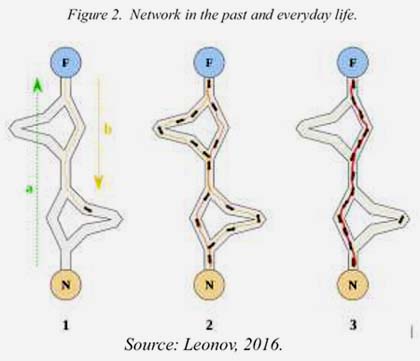
-Computer and Hardware Resources
Hardware:
-
Desktop PC(Laptop Lenovo Y560).
-
Server: DELL Power Edge R620.
-
Routers: Cisco 2800.
Software:
-
64-bit Operating System Windows 7 Home Premium.
-
Linux Operating System: Ubuntu Server 14.04.1 LTS.
-
VirtualBox 4.3.20.
-
Traffic Analysis Tool Argus v 3.0.0.0.
-
Software simulation networks: Packet Tracert V 6.1.
-
MATLAB R2010a version 7.10.0.499 32 bits (win32).
-
Microsoft Excel Version: 2010 14.0.7128.5000 (64-bit).
RESULTS
The results were obtained based on certain objectives according to the methodology of this research, and the main results will be presented.
1.1. Application of results obtained by Ant Algorithm in Network Testing
The network model used for this research represents 9 nodes connected with type Ethernet links (100MB / s) and type serial (128KB / s) in the form of graph presented below:
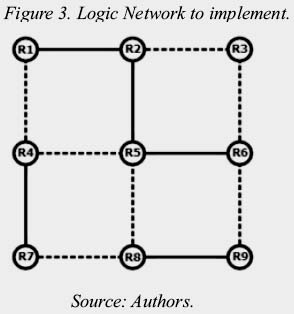
The start and end nodes are the nodes R1 and R9, where the server and the host where the relevant measures will take place will be placed.
1.1. Conditions To Consider
A compressed file 1.85 MB which will be sent for ten consecutive times in the scenario described above.
1.2. Results variation algorithm parameters to optimize ant behavior
In determining optimum parameters in Matlab, it was noted according to the variation of parameters number of iterations, ants, among others the following routes recognized.
We note that gives sane parameter variations, Ant Algorithm choose different routes. The summary indicated in the following charts:
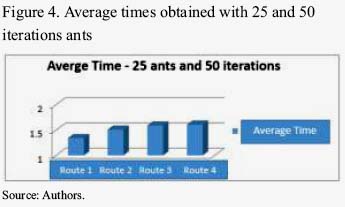
Of the three charts we can see that Route 1 is the lowest cost, as it goes by faster connections (Fast Ethernet) and the optimal combination is 25 ants and 50 iterations.
STAGE: With optimal parameters determined in the previous section, a comparison with two established protocols is performed. All protocols chose one of the following routes, as both have the same cost:
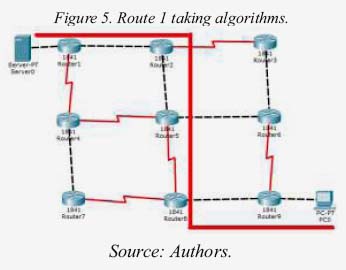
For each package calculates the average arrival time. It is worth mentioning that due to the extension package routers make the decision to send the original package into two parts (window size they choose).
The following table shows the results on average obtained for the first scenario.
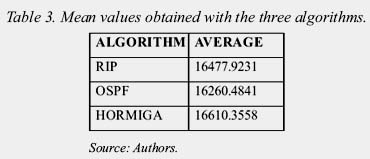
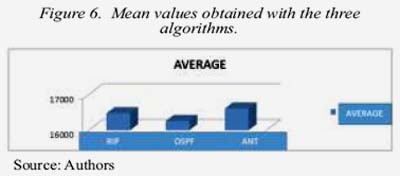
Clearly we noticed the ant algorithm is faster than RIP at 0.797%. While Ant algorithm is faster than OSPF in approximately 2.10%. Finally also we noticed that the algorithm is faster than RIP OSPF approximately 1.32%.
DISCUSSION
The use of ant algorithm to determine the best route in a given data network. To test the first hypothesis, the following operational assumptions are used. It is likely that the use of ant algorithm to determine the best route in a given data network. From the results, we note that on average Ant algorithm works and is faster compared to the algorithm OSPF approximately 2.16% and 0.45% RIP algorithm. This performing ANOVA with lower probability to 0.01% and F obtained from 9.05989.
Lu on 2016 says: "The objective function includes the key factors, such as the time delay, the bandwidth and the energy consumption of the link from the source to the destination. Also, in order to optimize the path selection, to ensure that the data forwarding node safety, the trust value of neighbor nodes is introduced to the fitness function. Simulation results show that this proposed algorithm prolongs lifetime of whole network, and obtain fast, secure and energy-efficient routing in communication process". The purpose of our research is to obtain the optimum parameters to make the algorithm funtional choosing the best route to a destination, and not to obtain the key factors to determine the best route to a destination, while Lu focuses on the parameters of the network such as bandwidth, delays among others, in the present investigation we turn to algorithm parameters such as the number of iterations to choose the best path. Although initially different criteria appear, both approaches ultimately lead to the solution of traffic problems in the network.
Leonov on 2016 says: "FANET routing is an extremely complicated problem. The article describes the bee algorithm and the routing process based on the mentioned algorithm in ad hoc networks. The classification of FANET routing methods is given. The overview of the routing protocols based on the bee colony algorithms is provided. Owing to the experimental analysis, bio-inspired algorithms based on the bee colony were proved to show good results, having better efficiency than traditional FANET routing algorithms in most cases". The purpose of our research is to make iterations to determine a specific value as a result, and not try to describe how the algorithm works, both the ant and bees algorithms are part of the heuristic goal called the swarm algorithm, so the results of the Leonov study reinforce the results obtained in this research work.
Ramesh on 2013 says: "The Intermittently Connected Mobile Networks (ICMN) is a disconnected mobile network where a complete connectivity never exists. The intermittent connectivity is due to the dense nature of the network. The dense nature is mainly due to the high mobility of the nodes in the network. Routing in such a sparse network is arduous. Due to the disconnected attribute of the network, the encounter of the suspicious nodes in the network also remains a tedious task. In this paper, we put forward a secure routing that aids in detecting and preventing intrusion of malicious nodes. The routing process is made adorable through ANT colony optimization (ACO) technique. In accordance to the ACO, a new protocol Ant Routing Protocol (ARP) is designed ensuring efficient routing in ICMN." From the above we can deduce that the algorithm of the ant applied to mobile networks also provides an adequate solution. This also agrees with the type of network that we use in this investigation, which is a wired network.
CONCLUSIONS
It was possible to design a routing algorithm based on the metaheuristic: Method ant, being applied in a defined network routers. The algorithm was implemented using the Matlab software, giving results according to all the required characteristics, achieving some optimum parameters determine: which of the determined optimal routes with values 25 and 50 iterations ants. Two types of results according to the original network and network changes were obtained. For the original network routing algorithm with Ant it was higher than RIP 0.45%, while OSPF was higher by 2.17%. Changes to network with ant algorithm was higher than RIP 0.45%, while OSPF was lower by 1.73%.
ACKNOWLEDGEMENTS
We thank our families and good friends who help us at all times. We also thank you to our university for all the support.
BIBLIOGRAPHIC REFERENCES
Alexandrovich, D. & Yurievich, I. (2016). Paired transitions algorithm of communication links in computer networks based on subnet routing method. IEEE Xplore. Visited 10 August 2016 on http://ieeexplore.ieee.org/document/7525755/
Cruz, J. (2014). Diseño e implementacion de un algoritmo de encaminamiento para una red de routers basado en algoritmo antnet para mejorar la transmision en redes de datos. Disertación doctoral, Facultad de Producción y Servicios, Universidad Nacional de San Agustín. Arequipa, Perú.
Lammle, T. (2014). CCNA/CCENT IOS Commands Survival Guide: Exams 100101, 200-101, and 200-120 2nd Edition. United States of America, Sybex.
Lammle, T. (2013). CCNA Routing and Switching Study Guide: Exams 100-101, 200-101, and 200-120 1st Edition. United States of America, Sybex.
Leonov, A. (2016). Application of bee colony algorithm for FANET routing. IEEE Xplore. Visited 13 August 2016 on http://ieeexplore.ieee.org/document/7538709/
Luo, Z.; Lu, L.; Xie, J. & He, J. (2016). An ant colony optimization-based trustful routing algorithm for wireless sensor networks. IEEE Xplore. Visited 1 July 2016 on http://ieeexplore.ieee.org/document/7490933/
Moriya, H. & Miura, Y. (2016). Performance improvement method of the adaptive routing algorithm for 2-dimensional torus network. IEEE Xplore. Visited 1 August 2016 on http://ieeexplore.ieee.org/document/7521019/
Sachdev, A.; Mehta, K. & Malik, L. (2016). Design of Protocol For Cluster based routing in VANET Using Fire Fly Algorithm. IEEE Xplore, Visited 19 September 2016 on http://ieeexplore.ieee.org/document/7569301/
Sadrosadati, M.; Bashizade, R.; Roozkhosh, S.; Shafiee, A. & Sarbazi-Azad, H. (2016). A Method to Improve Adaptivity of Odd-Even Routing Algorithm in Mesh NoCs. IEEE Xplore, Visited 29 April 2016 on http://ieeexplore.ieee.org/document/7445418/
Umale, M. & Markande S. D. (2016). Network and Energy efficient routing algorithm on the target tracking in Wireless Sensor. IEEE Xplore. Visited 1 July 2016 on http://ieeexplore.ieee.org/document/7489373/
Wang, G.; Shao M.; Li, R.; Ma, Y. & Wang, B. (2016). Spray and Wait routing algorithm based on Transfer Utility of Node in DTN. IEEE Xplore. Visited 1 July 2016 on http://ieeexplore.ieee.org/document/7489883/
Wang, L.; Wang, X. & Mak T. (2015). Adaptive Routing Algorithms for Lifetime Reliability Optimization in Network-on-Chip. IEEE Xplore, Visited 9 April 2016 on http://ieeexplore.ieee.org/document/7349176/authors
Wei, Y. & Wang, J. (2016). A DTN Routing Algorithm Based on Traffic Prediction. IEEE Xplore. Visited 7 August 2016 on http://ieeexplore.ieee.org/document/7528887/
Xu, Z.; Zhu, F.; Fu, Y.; Liu, Q. & You, S. (2016). A dyna-Q based multi-path load-balancing routing algorithm in wireless sensor networks. IEEE Xplore. Visited 1 July 2016 http://ieeexplore.ieee.org/document/7461455/
Zhihui, H. (2016). Research on WSN Routing Algorithm Based on Energy Efficiency. IEEEXplore. Visited 1 July 2016 on http://ieeexplore.ieee.org/document/7462714/
Correspondencia
Jose Emmanuel Cruz de la Cruz
jeccruz@yahoo.com,
Eudes Rigoberto Apaza Estaño
lamegaperu@gmail.com,
Luis Enrique Baca Wiesse
luisenriquebaca@gmail.com
Article received 30-09-2016
Article accepted 09-12-2016
On line: 20-12-2016













